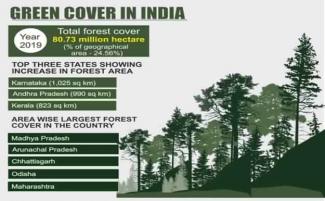
The Union Minister for Environment, Forest and Climate Change, Shri Prakash Javadekar today released the biennial “India State of Forest Report (ISFR)”, in New Delhi. The report is published by the Forest Survey of India (FSI) which has been mandated to assess the forest and tree resources of the country including wall-to-wall forest cover mapping in a biennial cycle. Starting 1987, 16 assessment have been completed so far. ISFR 2019 is the 16th report in the series.
Announcing the results the Union Minister said that India is among few countries in the world where forest cover is consistently increasing. Shri Javadekar told that in the present assessment, the total forest and tree cover of the country is 80.73 million hectare which is 24.56 percent of the geographical area of the country.
The Environment Minister further said that as compared to the assessment of 2017, there is an increase of 5,188 sq. km in the total forest and tree cover of the country. “Out of this, the increase in the forest cover has been observed as 3,976 sq km and that in tree cover is 1,212 sq. km; Range increase in forest cover has been observed in open forest followed by very dense forest and moderately dense forest and the top three states showing increase in forest cover are Karnataka (1,025 sq. km) followed by Andhra Pradesh (990 sq km) and Kerala (823 sq km).”, said the Minister.
Some Major Findings
Area-wise Madhya Pradesh has the largest forest cover in the country followed by Arunachal Pradesh, Chhattisgarh, Odisha and Maharashtra. In terms of forest cover as percentage of total geographical area, the top five States are Mizoram (85.41%), Arunachal Pradesh (79.63%), Meghalaya (76.33%), Manipur (75.46%) and Nagaland (75.31%).
The Mangrove ecosystems are unique & rich in biodiversity and they provide numerous ecological services. Mangrove cover has been separately reported in the ISFR 2019 and the total mangrove cover in the country is 4,975 sq km. An increase of 54 sq Km in mangrove cover has been observed as compared to the previous assessment of 2017. Top three states showing mangrove cover increase are Gujarat (37 sq km) followed by Maharashtra (16 sq km) and Odisha (8 sq km).
The total growing stock of India’s forest and TOF is estimated 5,915.76 million cum of which 4,273.47 million cum is inside the forests and 1,642.29 million cum outside. There is an increase of 93.38 million cum of total growing stock, as compared to the previous assessment. Out of this the increase in growing stock, there is an increase of 55.08 million cum inside the forests and 38.30 million cum outside the forest areas.
The extent of bamboo bearing area of the country has been estimated 16.00 million hectare. There is an increase of 0.32 million hectare in bamboo bearing area as compared to the last assessment of ISFR 2017. The total estimated green weight of bamboo culms is 278 million tonnes, slowly an increase of 88 million tonnes as compared to ISFR 2017.
Under the current assessment the total carbon stock in country’s forest is estimated 7,124.6 million tonnes and there an increase of 42.6 million tonnes in the carbon stock of country as compared to the last assessment of 2017. The annual increase in the carbon stock is 21.3 million tonnes, which is 78.2 million tonnes CO2 eq.
Wetlands within forest areas form important ecosystems and add richness to the biodiversity in forest areas, both of faunal and floral species. Due to importance of wetlands, FSI has carried out an exercise at the national level to identify wetlands of more than 1 ha within RFA. There are 62,466 wetlands covering 3.8% of the area within the RFA/GW of the country.
OTHER HIGHLIGHTS
The accuracy level achieved in the current assessment is the highest amongst all the previous assessments. The accuracy of forest cover classification has been assessed 93.17% .The accuracy of classification between forest and non-forest classes has been assessed 97.20%.
A study to assess the dependence of the people living in close proximity to forests for their day to day needs like fuelwood, fodder, small timber and bamboo was undertaken by FSI during September 2018 to June 2019. Findings of the study in various States/UTs has been presented in the report.
The present report also gives information on the fire prone forest areas of different severity classes, mapped in the grids of 5km x 5km based on the frequency of forest fires in the last 14 years that would enable the SFDs to manage and control forest fires effectively in the respective States.
Non Timber Forest Produce (NTFP) are important source of livelihood for many tribal communities and villagers living in the proximity of forests. A new information has been generated from the national forest inventory data about the top five NTFP species in each State & UT in terms of their availability in forests i.e. relative occurrence. The information has been presented in the respective sub-chapter of each State & UT of the country in Vol II.
Invasive species pose serious threat to the sustainable management of forests. Analysis of NFI data has been done for determining five major invasive species in each State & UT and also an estimate of area affected by them. This information has been presented in the respective sub chapter of each State & UT of the country in Vol II.
The information given in the report would provide valuable information for policy, planning and sustainable management of forest and tree resources in the country.
Vol-I of the Report, Click http://164.100.117.97/WriteReadData/userfiles/ISFR2019%20Vol-I.pdf
Vol-II of the Report, Click http://164.100.117.97/WriteReadData/userfiles/ISFR2019%20Vol-II.pdf










